- Kamigamo Jinja 上賀茂神社
- Shimogamo Jinja 下鴨神社
- Toji 東寺
- Kiyomizu-dera 清水寺
- Daigoji 醍醐寺
- Ninnaji 仁和寺
- Kozanji 高山寺
- Saihoji / Koke-dera (Moss Temple) 西芳寺
- Tenryuji 天龍寺
- Rokuonji / Kinkakuji (Golden Pavilion) 金閣寺
- Jishoji / Ginkakuji (Silver Pavilion) 銀閣寺
- Ryoanji 龍安寺
- Nishi Honganji 西本願寺
- Nijo-jo (Nijo Castle) 二条城
- Enryakuji 延暦寺
- Byodoin 平等院
- Ujigami Jinja 宇治上神社
Kiyomizu-dera清水寺6AM to 6PM (630PM August and September)Admission fee: 300 yen
Directions to Kiyomizu-dera: Take bus 86 / 100 / 106 / 110 / 202 / 206 / 207 to Gojozaka or Kiyomizu-michi bus stop. From either stop, it is a 10-minute uphill walk to Kiyomizu-dera.
It was my mistake that I did not read up on Kiyomizu-dera before visiting. Have I done so, I would have spent more time in this temple rather than just let myself get caught in the sea of visitors having a look-see at the vermilion gates, pagoda, and buildings.
Right by the base of the Hondo (main hall), I'd have drank a scoop of water from one of the streams of Otowa Waterfall (there are three streams: for study, for good health, for a romantic relationship) rather than just observe the other visitors do so. And I'd have elbowed my way through the crowd to get to Jishu Shrine, located behind the Hondo, just to touch the love stones! Guess I will have to go back to Kiyomizu-dera to try my luck at love!
FYI: Renovation work on Kiyomizu-dera's main hall started on February 2017 and will go on until March 2020. The main hall will be covered during the renovation period.
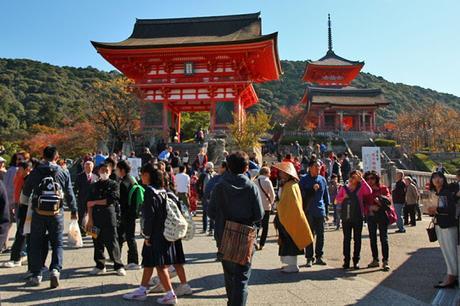 At the main entrance of Kiyomizu-dera: Nio-mon on the left, Sai-mon on the right
At the main entrance of Kiyomizu-dera: Nio-mon on the left, Sai-mon on the right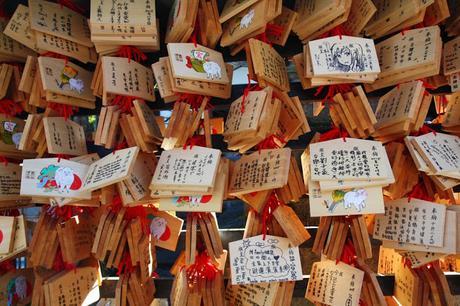 Prayers or wishes written on wooden plaques called ema
Prayers or wishes written on wooden plaques called ema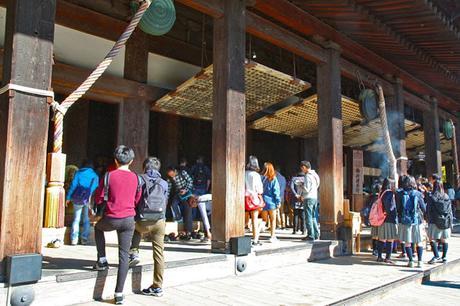 At the Hondo (main hall)
At the Hondo (main hall)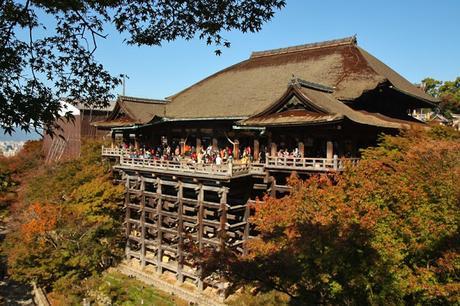 The Hondo's Kiyomizu Stage stands 13 meters high
The Hondo's Kiyomizu Stage stands 13 meters high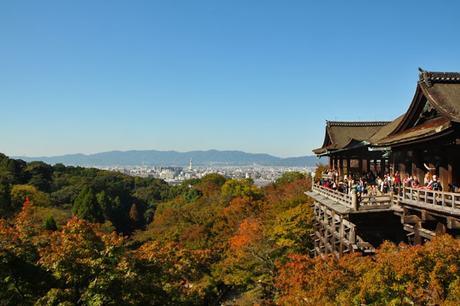 Looking at Hondo (on the right) and the city of Kyoto
Looking at Hondo (on the right) and the city of Kyoto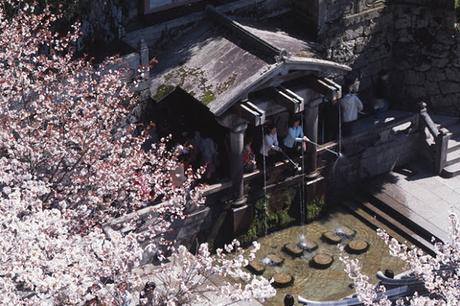 Otowa Waterfall, from which stream would you drink from? (Photo from Kiyomizudera website)
Otowa Waterfall, from which stream would you drink from? (Photo from Kiyomizudera website)BONUS! When we exited Kiyomizu-dera, we found ourselves in Higashiyama District, a preserved historic district with rows and rows of traditional buildings, giving it an old world atmosphere. This instantly became my favorite place in Kyoto! For anyone who plans to visit Kyoto, I highly recommend including a visit to Higashiyama District in your itinerary!
 Higashiyama District
Higashiyama DistrictNijo-jo (Nijo Castle)二条城845AM to 4PMClosed on Tuesdays of January, July, August, DecemberAdmission fee: 600 yenEnglish audio guide rental: 500 yen
Directions to Nijo Castle: Take the Tozai subway line to Nijojo-mae Station. Or take bus 9 / 12 / 50 / 101 to Nijojo-mae bus stop.
When I think of Japanese castles, I think of four- or five-storied imposing structures. I think Himeji Castle, Hiroshima Castle, Osaka Castle. Or even Tokyo Imperial Palace, or what little of it I had seen across its moat.
But Nijo Castle is not four- or five-storied. I can't even see its roof when I am outside the castle ground walls. The buildings look nothing like the picture that I have associated with the word castle. Instead Nijo Castle's Karamon gate and buildings somehow remind me of Kyoto Imperial Palace. But, whatever, that's just me and my untrained near-sighted eyes.
Nijo Castle has two buildings: Ninomaru Palace and Honmaru Palace. Castle? Palace? Huh? Don't look at me, I am confused myself. We entered Ninomaru Palace but not Honmaru Palace (closed to the public). Ninomaru Palace is huge with 33 rooms and impressive wall paintings (no taking of photos allowed in Ninomaru Palace). But what stood out to me was the "nightingale floor", chirping with even the lightest of footsteps.
 Karamon (gate)
Karamon (gate)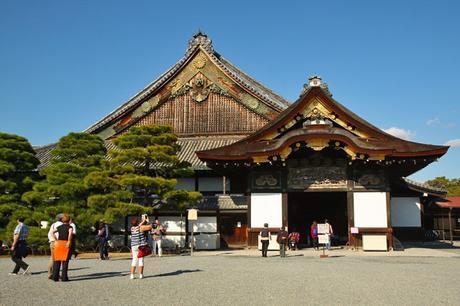 Ninomaru Palace
Ninomaru Palace The backside of Ninomaru Palace
The backside of Ninomaru Palace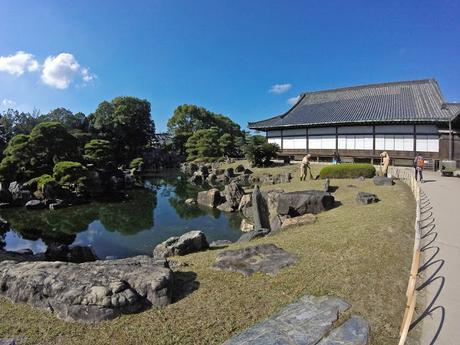 Ninomaru Garden
Ninomaru Garden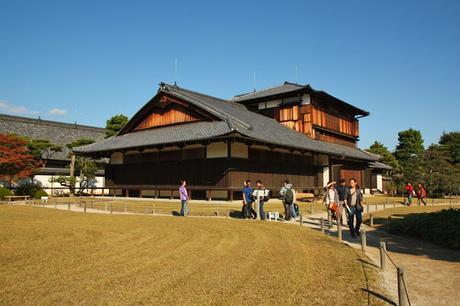 Honmaru Palace
Honmaru PalaceRokuonji / Kinkakuji (Golden Pavilion)
金閣寺9AM to 5PMAdmission fee: 400 yen
Directions to Kinkakuji: Take bus 12 / 59 / 101 / 102 / 204 / 205 to Kinkakuji-michi bus stop.
We visited Kinkakuji, formally known as Rokuonji and commonly known as the Golden Pavilion, during the golden hour and what did we see? A million heads blocking our view. There were so many people at the temple grounds, we had to search for an opening between camera-wielding bodies that formed a barrier along the pond's perimeter. When we managed to squeeze in shoulder to shoulder, we were blinded by the pavilion's beauty! Kinkakuji was a mesmerizing sight with the golden building reflected on the pond and standing out from a background of mountains and trees. That's all we could do at Kinkakuji, gaze at it even as we circle the pond towards the exit because there is nothing else to do there but admire it (the temple building itself is not open to the public).
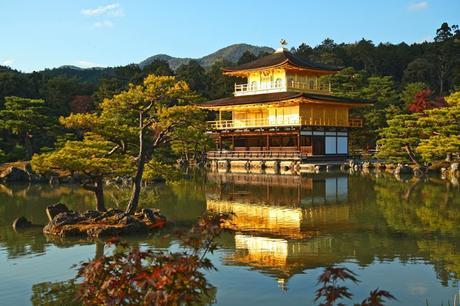 The Golden Pavilion during golden hour
The Golden Pavilion during golden hourTransportation Tip: The bus network in Kyoto City is extensive and the UNESCO World Heritage Sites mentioned above (except for Daigoji, Kozanji, Enryakuji, Byodoin, and Ujigami Jinja) can easily be reached by city bus. The bus fare flat rate is 230 yen. If you plan to take the bus at least three times in a day, the one-day city bus pass (500 yen) is recommended. Check with your hostel if they sell the bus pass; if they don't, you can buy the pass at any bus/subway information center or ticket office. I personally recommend installing Arukumachi Kyoto app and having a pocket WiFi with you. But if you are inclined on going old school, the bus pass usually comes with a route map (if they forget to give you one, don't hesitate to ask).
JapanKnow Before You Go
Single Entry Tourist Visa for Japan
Roam Around Japan with a Swagger
From Tokyo to Hiroshima (2015)
10D/9N | Tokyo, Toyama, Kyoto, Hyogo, Osaka, Hiroshima
Tokyo Accommodation: Shinjuku Airbnb
Tokyo: Memorable Tokyo Eats
Tokyo: Odaiba
Tokyo: Doing Touristy Things in Tokyo
Toyama: A Hamlet Called Ainokura
Kyoto Accommodation: K's House Hostel Kyoto
Kyoto, Japanecdote: Wisdom from the Road: On exits #2
Kyoto: By the Thousands (Kyoto Imperial Palace, Sanjusangendo, Fushimi Inari Taisha, Arashiyama Bamboo Grove)
Kyoto, Japanecdote: Turning Japanese
Kyoto: Braving the Crowds at these UNESCO World Heritage Sites in Kyoto (you're here!)
Concentrate on Kansai (2016)
Kyoto Accommodations: Guesthouse Wind Villa, Shiori Yado

